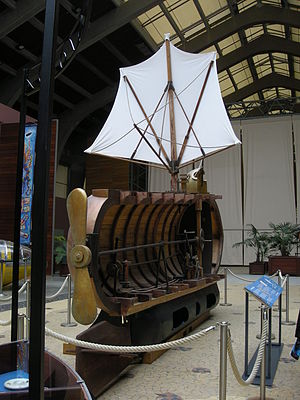Nautilus (1800 submarine)

Full-sized section model at Cité de la Mer, Cherbourg, France
|
|
| History | |
|---|---|
| Name: | Nautilus |
| Laid down: | Perrier boatyard in Rouen |
| General characteristics | |
| Length: | 21 ft, 3in |
| Beam: | 6ft. 4 in. |
| Propulsion: | Hand-cranked screw propeller or Sail (when surfaced) |
Nautilus was a submarine first tested in 1800. Though preceded by Cornelius Drebbel's vessel of 1620, Nautilus is often considered to be the first practical submarine.
The Nautilus was designed between 1793 and 1797 by the American inventor Robert Fulton, then living in the French First Republic. He unsuccessfully proposed to the Directory that they subsidize its construction as a means to balance British seapower. His second, also unsuccessful, proposal to them was that he be paid nothing until the Nautilus had sunk British shipping, and then only a small percentage of the prize money. Fulton directed his next proposal to the Minister of Marine, who granted him permission to build.
Fulton built the first Nautilus of copper sheets over iron ribs at the Perrier boatyard in Rouen. It was 21 ft 3 in (6.48 m) long and 6 ft 4 in (1.93 m) in the beam. Propulsion was provided by a hand-cranked screw propeller. The hollow iron keel was the vessel's ballast tank, flooded and emptied to change buoyancy. Two horizontal fins, diving planes in modern terms, on the stubby horizontal rudder controlled angle of dive. Overall, Nautilus resembled a modern research submarine, such as the NR-1, having a long teardrop hull. The design included an observation dome, somewhat similar in appearance, if not function, to the conning tower of later submarines. When surfaced, a fan-shaped collapsible sail, reminiscent of those popular on Chinese ships, could be deployed. Air, beyond that enclosed within the vessel, could be provided by a snorkel constructed of waterproofed leather.
Nautilus was designed from the start to carry what Fulton called a "carcass", a naval mine intended to be dragged into contact with an enemy ship. A device on the top of the dome drove a spiked eye into the enemy's wooden hull. The submarine then released its mine on a line that went through the eye. The submarine sped away. When the long line had paid out, the mine would strike the target hull and explode by a detonator. These "carcasses" were variously sized copper cylinders carrying between ten and two hundred pounds of gunpowder. Contact with the hull triggered a gunlock mechanism.
...
Wikipedia
